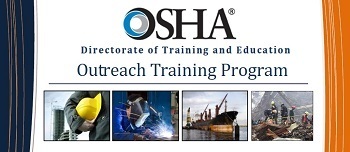 OSHA's Outreach Training Program and CPWR - The Center for Construction Research and Training have developed a new OSHA 30-hour construction training elective course: Foundations for Safety Leadership. Responding to a training gap identified by contractors, unions and other industry stakeholders, FSL is designed to introduce construction workers, particularly foremen and lead workers, to five critical safety leadership skills needed to improve jobsite safety climate and safety outcomes. The course stresses the importance of leading by example, engaging and empowering team members, listening and communicating effectively, coaching and providing feedback, and recognizing team members who go above and beyond for safety. The FSL course will be available on OSHA’s Outreach Training Program webpage starting January 1, 2017.
OSHA's Outreach Training Program and CPWR - The Center for Construction Research and Training have developed a new OSHA 30-hour construction training elective course: Foundations for Safety Leadership. Responding to a training gap identified by contractors, unions and other industry stakeholders, FSL is designed to introduce construction workers, particularly foremen and lead workers, to five critical safety leadership skills needed to improve jobsite safety climate and safety outcomes. The course stresses the importance of leading by example, engaging and empowering team members, listening and communicating effectively, coaching and providing feedback, and recognizing team members who go above and beyond for safety. The FSL course will be available on OSHA’s Outreach Training Program webpage starting January 1, 2017.Tuesday, December 20, 2016
OSHA offers new outreach training elective on safety leadership
 OSHA's Outreach Training Program and CPWR - The Center for Construction Research and Training have developed a new OSHA 30-hour construction training elective course: Foundations for Safety Leadership. Responding to a training gap identified by contractors, unions and other industry stakeholders, FSL is designed to introduce construction workers, particularly foremen and lead workers, to five critical safety leadership skills needed to improve jobsite safety climate and safety outcomes. The course stresses the importance of leading by example, engaging and empowering team members, listening and communicating effectively, coaching and providing feedback, and recognizing team members who go above and beyond for safety. The FSL course will be available on OSHA’s Outreach Training Program webpage starting January 1, 2017.
OSHA's Outreach Training Program and CPWR - The Center for Construction Research and Training have developed a new OSHA 30-hour construction training elective course: Foundations for Safety Leadership. Responding to a training gap identified by contractors, unions and other industry stakeholders, FSL is designed to introduce construction workers, particularly foremen and lead workers, to five critical safety leadership skills needed to improve jobsite safety climate and safety outcomes. The course stresses the importance of leading by example, engaging and empowering team members, listening and communicating effectively, coaching and providing feedback, and recognizing team members who go above and beyond for safety. The FSL course will be available on OSHA’s Outreach Training Program webpage starting January 1, 2017.New fact sheets provide information on changes to electric power standards
A new series of fact sheets outline changes made in 2014 to OSHA's general industry and construction standards covering work involving electric power generation, transmission and distribution lines and equipment. The revisions were made to better protect workers, while also making the two standards more consistent. The fact sheets highlight some of the major changes in the standards, as well as requirements for electrical protective equipment, fall protection, and minimum approach distance, information transfer and training.
New bilingual cards explain whistleblower rights protected under five federal statutes
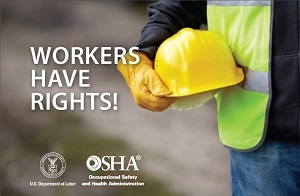 OSHA has released new cards explaining employee whistleblower rights protected by the agency under five federal statutes covering occupational safety and health, commercial motor carriers, railroads, aviation, and securities fraud. Each card explains the activities protected by a specific statute, and provides contact information for OSHA and the time limit for filing a retaliation complaint. The information on each card is printed in English on one side and Spanish on the other
OSHA has released new cards explaining employee whistleblower rights protected by the agency under five federal statutes covering occupational safety and health, commercial motor carriers, railroads, aviation, and securities fraud. Each card explains the activities protected by a specific statute, and provides contact information for OSHA and the time limit for filing a retaliation complaint. The information on each card is printed in English on one side and Spanish on the other
OSHA extends deadline for comments on proposed rule to improve provisions in its standards
 OSHA is extending the comment period for its proposal to revise provisions that may be confusing, outdated or unnecessary in the agency's recordkeeping, general industry, maritime and construction standards. Originally scheduled to expire Dec. 5, the comment period will be extended to Jan. 4, 2017, to allow parties more time to review the rule and collect necessary information and data for comments. Individuals may submit comments electronically at www.regulations.gov. Comments also may be submitted by facsimile or mail.
OSHA is extending the comment period for its proposal to revise provisions that may be confusing, outdated or unnecessary in the agency's recordkeeping, general industry, maritime and construction standards. Originally scheduled to expire Dec. 5, the comment period will be extended to Jan. 4, 2017, to allow parties more time to review the rule and collect necessary information and data for comments. Individuals may submit comments electronically at www.regulations.gov. Comments also may be submitted by facsimile or mail.
OSHA issues recommended practices to promote workplace safety and health programs in construction
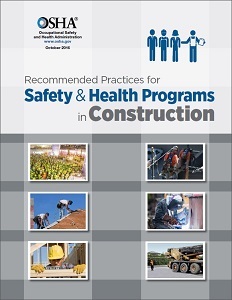 As a complement to its recommended practices to help employers in general industry establish safety and health programs in their workplaces, OSHA has released Recommended Practices for Safety and Health Programs in Construction. The recommendations may be particularly helpful to small- and medium-sized contractors who may not have safety and health specialists on staff. The goal of safety and health programs is to prevent work-related injuries, illnesses and deaths as well as the financial difficulties these events can cause for workers, their families and their employers. For more information, see the news release.
As a complement to its recommended practices to help employers in general industry establish safety and health programs in their workplaces, OSHA has released Recommended Practices for Safety and Health Programs in Construction. The recommendations may be particularly helpful to small- and medium-sized contractors who may not have safety and health specialists on staff. The goal of safety and health programs is to prevent work-related injuries, illnesses and deaths as well as the financial difficulties these events can cause for workers, their families and their employers. For more information, see the news release.
Ohio worker's death highlights doubling of trench collapse fatalities nationwide in 2016
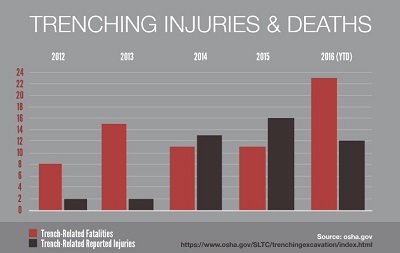 Twenty-three workers have been killed and 12 others injured in trench collapses so far in 2016 – an alarming increase from the previous year. "There is no excuse,” said Dr. David Michaels, OSHA assistant secretary. "These fatalities are completely preventable by complying with OSHA standards that every construction contractor should know."
Twenty-three workers have been killed and 12 others injured in trench collapses so far in 2016 – an alarming increase from the previous year. "There is no excuse,” said Dr. David Michaels, OSHA assistant secretary. "These fatalities are completely preventable by complying with OSHA standards that every construction contractor should know."
Among the victims was a 33-year-old employee, crushed to death this summer as he dug a 12-foot trench for KRW Plumbing LLC of Ohio. An OSHA investigation found that KRW failed to protect its workers from the dangers of trench collapses. The company was issued two willful and two serious violations, with proposed penalties of $274,359.
OSHA's trenching standards require protective systems on trenches deeper than 5 feet, with soil and other materials kept at least two feet from the edge of trench. OSHA has a national emphasis program on trenching and excavations with the goal of increasing hazard awareness and employer compliance with safety standards. For more information, read the news release.
New final rule updates walking-working surfaces standards and establishes personal fall protection requirements
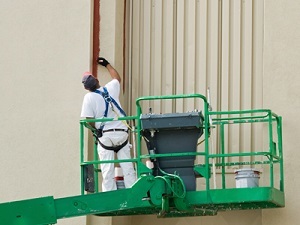 OSHA issued a final rule Nov. 17 updating its 44-year old general industry Walking-Working Surfaces standard to protect workers from slip, trip, and fall hazards. The rule also increases consistency in safety and health standards for people working in both general and construction industries. OSHA estimates the final rule will prevent more than 5,800 injuries a year. The rule takes effect Jan. 17, 2017.
OSHA issued a final rule Nov. 17 updating its 44-year old general industry Walking-Working Surfaces standard to protect workers from slip, trip, and fall hazards. The rule also increases consistency in safety and health standards for people working in both general and construction industries. OSHA estimates the final rule will prevent more than 5,800 injuries a year. The rule takes effect Jan. 17, 2017.
"The final rule will increase workplace protection from those hazards, especially fall hazards, which are a leading cause of worker deaths and injuries," said OSHA Assistant Secretary Dr. David Michaels. The rule's most significant update is allowing employers to select the fall protection system that works best for them, choosing from a range of accepted options. For more information, read the news release.
Monday, November 21, 2016
New guide will help small businesses comply with OSHA's silica rule for construction
 OSHA has released a Small Entity Compliance Guide for Construction that is intended to help small business employers comply with the agency's Final Rule to Protect Workers from Exposure to Respirable Crystalline Silica. The guide describes in easy-to-understand language the steps that employers are required to take to protect employees in construction from the hazards associated with silica exposure. All covered must: provide respiratory protection when required; restrict silica exposure from housekeeping practices where feasible; implement a written exposure control plan; offer medical exams to workers who will need to wear a respirator for 30 or more days a year; communicate hazards and train employees; and keep records of medical examinations. Enforcement of the final rule in construction is due to begin June 23, 2017.
OSHA has released a Small Entity Compliance Guide for Construction that is intended to help small business employers comply with the agency's Final Rule to Protect Workers from Exposure to Respirable Crystalline Silica. The guide describes in easy-to-understand language the steps that employers are required to take to protect employees in construction from the hazards associated with silica exposure. All covered must: provide respiratory protection when required; restrict silica exposure from housekeeping practices where feasible; implement a written exposure control plan; offer medical exams to workers who will need to wear a respirator for 30 or more days a year; communicate hazards and train employees; and keep records of medical examinations. Enforcement of the final rule in construction is due to begin June 23, 2017.
New research demonstrates how occupational safety and health can play a key role in business sustainability strategies
 Although "sustainability" has been traditionally associated with environmental activities, there is a growing movement to expand the definition. The Campbell Institute at the National Safety Council recently released a white paper, Profiles in Sustainability: Business, Community, and Environment, describing how member companies are integrating worker safety and health into their overall sustainability planning. Safety and health professionals can use the information to define, drive, measure and report their own sustainability efforts.
Although "sustainability" has been traditionally associated with environmental activities, there is a growing movement to expand the definition. The Campbell Institute at the National Safety Council recently released a white paper, Profiles in Sustainability: Business, Community, and Environment, describing how member companies are integrating worker safety and health into their overall sustainability planning. Safety and health professionals can use the information to define, drive, measure and report their own sustainability efforts.
Public meetings set on hazard communication issues: potential rulemaking and interagency collaboration
OSHA will hold a public meeting to discuss potential updates to the Hazard Communication Standard on Nov. 16, 2016, in Arlington, Va. OSHA is beginning its rulemaking efforts to maintain alignment of the Hazard Communication Standard with the most recent revision of the United Nations Globally Harmonized System of Classification and Labelling of Chemicals. The agency is requesting feedback from stakeholders on issues that they would like OSHA to consider in the rulemaking. The meeting will be held from 9 a.m. – 12:30 p.m. at the Mine Safety and Health Administration Headquarters, 201 12th St. South, Suite 700, Arlington, Va. 22202. For more information on conference call-in capability and pre-registration instructions, see the Federal Register notice.
 In addition, two meetings related to hazardous materials are set for Nov. 15 at Department of Transportation's headquarters in Washington, DC. In the morning, from 9 to noon, DOT's Pipeline and Hazardous Materials Safety Administration will discuss proposals in preparation for the United Nations Sub-Committee of Experts on the Transport of Dangerous Goods session in Switzerland later this year. From 1 to 4 p.m., OSHA will host a public meeting of the U.S. Interagency System of Classification and Labelling of Chemicals Coordinating Group. Topics will include an update on GHS-related issues and a discussion of public comments. For more information on conference call-in capability and pre-registration instructions, see the Federal Register notice.
In addition, two meetings related to hazardous materials are set for Nov. 15 at Department of Transportation's headquarters in Washington, DC. In the morning, from 9 to noon, DOT's Pipeline and Hazardous Materials Safety Administration will discuss proposals in preparation for the United Nations Sub-Committee of Experts on the Transport of Dangerous Goods session in Switzerland later this year. From 1 to 4 p.m., OSHA will host a public meeting of the U.S. Interagency System of Classification and Labelling of Chemicals Coordinating Group. Topics will include an update on GHS-related issues and a discussion of public comments. For more information on conference call-in capability and pre-registration instructions, see the Federal Register notice.
Additional information about these public meetings is available on OSHA's Hazard Communication webpage.
OSHA Assistant Secretary encouraged by drop in workplace injury, illness rates
 Recently released occupational injury and illness data compiled by the Bureau of Labor Statistics showed a significant drop in the rate of recordable workplace injuries and illnesses in 2015. Private sector employers reported about 2.9 million nonfatal workplace injuries and illnesses in 2015, a decline of about 48,000 from 2014, despite an increase in total hours worked. The rate of cases recorded was 3.0 cases per 100 full-time workers – down from 3.2 in 2014. This rate has declined for all but one of the last 13 years.
Recently released occupational injury and illness data compiled by the Bureau of Labor Statistics showed a significant drop in the rate of recordable workplace injuries and illnesses in 2015. Private sector employers reported about 2.9 million nonfatal workplace injuries and illnesses in 2015, a decline of about 48,000 from 2014, despite an increase in total hours worked. The rate of cases recorded was 3.0 cases per 100 full-time workers – down from 3.2 in 2014. This rate has declined for all but one of the last 13 years.
"We are encouraged to see the significant decline in worker injury and illness rates," said OSHA Assistant Secretary Dr. David Michaels. "This is the result of the relentless efforts of employers, unions, worker advocates, occupational safety and health professionals, and federal and state government agencies ensuring that worker safety and health remains a top priority every day." For more information, read the full statement.
Monday, October 17, 2016
OSHA proposes rule to improve provisions in several standards
As part of an ongoing effort to revise provisions in its standards that may be confusing, outdated or unnecessary, OSHA is proposing 18 changes to the agency's recordkeeping, general industry, maritime and construction standards. "The changes we propose will modernize OSHA standards, help employers better understand their responsibilities, increase compliance and reduce compliance costs," said Assistant Secretary of Labor for Occupational Safety and Health Dr. David Michaels. Individuals may submit comments electronically via www.regulations.gov, by facsimile or mail by Dec. 5. See the news release or Federal Register notice for details.
OSHA proposes improvements to respiratory protection standard
 |
OSHA issued a Notice of Proposed Rulemaking to add two quantitative fit-testing protocols to the agency's Respiratory Protection Standard. The proposed protocols are variations of the existing OSHA-accepted PortaCount® protocol, but differ from it by the exercise sets, exercise duration, and sampling sequence. The protocols would apply to employers in the general, shipyard and construction industries. OSHA invites the public to comment on the accuracy and reliability of the proposed protocols. Individuals may submit comments electronically at www.regulations.gov, by mail or facsimile by Dec. 6. For more information, see the news release.
OSHA reaches out to grain-handling industry in response to recent tragedies and near disasters
 Since January, grain-handling facilities in Nebraska and Kansas have had four preventable incidents that resulted in two deaths. In March, a superintendent at a grain-handling site in Prosser, Neb., suffered fatal injuries caused by an operating auger as he drew grain from a bin. In May, a maintenance worker in West Point, Neb., died from injuries suffered when a wall of corn product in a grain bin collapsed and engulfed him. Other incidents also involved workers becoming trapped in a grain bin or injured by augers, including the amputation of a worker’s leg in Ellsworth, Kan.
Since January, grain-handling facilities in Nebraska and Kansas have had four preventable incidents that resulted in two deaths. In March, a superintendent at a grain-handling site in Prosser, Neb., suffered fatal injuries caused by an operating auger as he drew grain from a bin. In May, a maintenance worker in West Point, Neb., died from injuries suffered when a wall of corn product in a grain bin collapsed and engulfed him. Other incidents also involved workers becoming trapped in a grain bin or injured by augers, including the amputation of a worker’s leg in Ellsworth, Kan.
OSHA urges industry employers and workers to implement safety and health programs to avoid similar tragedies. OSHA officials spoke at several grain and feed association meetings in Nebraska and Kansas on the most common hazards in the grain industry, which include engulfment, falls, auger entanglement, "struck by," combustible dust explosions and electrocution. For more information, see the news release.
OSHA urges storm recovery workers, public to be aware of hazards in aftermath of Hurricane Matthew
 Emergency workers, employers and the public face exposures to serious hazards as they recover from Hurricane Matthew. Post-storm cleanup often presents hazards associated with restoring electricity, communications, water and sewer services. Activities such as tree trimming, road and structural repair, and hazardous waste operations can also pose serious dangers to workers' safety and health. "Recovery work should not send you to the hospital emergency room," said Kurt Petermeyer, OSHA's regional administrator for the Southeast. "You can minimize these dangers with knowledge, safe work practices and personal protective equipment." OSHA's website provides guidance to keep disaster-site workers safe in tornado and storm cleanup and recovery operations. Read the news release for links to OSHA storm-related cleanup resources.
Emergency workers, employers and the public face exposures to serious hazards as they recover from Hurricane Matthew. Post-storm cleanup often presents hazards associated with restoring electricity, communications, water and sewer services. Activities such as tree trimming, road and structural repair, and hazardous waste operations can also pose serious dangers to workers' safety and health. "Recovery work should not send you to the hospital emergency room," said Kurt Petermeyer, OSHA's regional administrator for the Southeast. "You can minimize these dangers with knowledge, safe work practices and personal protective equipment." OSHA's website provides guidance to keep disaster-site workers safe in tornado and storm cleanup and recovery operations. Read the news release for links to OSHA storm-related cleanup resources.
OSHA releases recommendations for creating a Safety and Health Plan
 OSHA Assistant Secretary David Michaels today released a set of Recommended Practices for Safety and Health Programs to help employers establish a methodical approach to improving safety at their workplaces. The recommendations update OSHA's 1989 guidelines to reflect changes in the economy, workplaces, and evolving safety and health issues. Key principles include: leadership from the top to send a message that safety and health is critical to business operations; worker participation in finding solutions; and a systematic approach to find and fix hazards. "We know that working together to implement these programs will help prevent injuries and illnesses, and also make businesses more sustainable," said Dr. Michaels, who released the document at the National Safety Council Congress in Anaheim, Calif. In his remarks, he asked business groups and safety and health professionals to help spread the word through a campaign that encourages creation of a safety and health program using OSHA's recommendations or others.
OSHA Assistant Secretary David Michaels today released a set of Recommended Practices for Safety and Health Programs to help employers establish a methodical approach to improving safety at their workplaces. The recommendations update OSHA's 1989 guidelines to reflect changes in the economy, workplaces, and evolving safety and health issues. Key principles include: leadership from the top to send a message that safety and health is critical to business operations; worker participation in finding solutions; and a systematic approach to find and fix hazards. "We know that working together to implement these programs will help prevent injuries and illnesses, and also make businesses more sustainable," said Dr. Michaels, who released the document at the National Safety Council Congress in Anaheim, Calif. In his remarks, he asked business groups and safety and health professionals to help spread the word through a campaign that encourages creation of a safety and health program using OSHA's recommendations or others.
New video released on filing an OSHA complaint
 OSHA has released a one-minute video, available in English and Spanish, to inform workers exposed to jobsite hazards of their right to file a complaint with OSHA. The video emphasizes that filing a complaint is easy and confidential and that it is illegal for employers to retaliate against workers for doing so.
OSHA has released a one-minute video, available in English and Spanish, to inform workers exposed to jobsite hazards of their right to file a complaint with OSHA. The video emphasizes that filing a complaint is easy and confidential and that it is illegal for employers to retaliate against workers for doing so.Two new fact sheets explain the importance of analysis in creating safer workplaces
Monday, September 19, 2016
Two new bulletins address the responsibility of employers to protect temporary workers
 OSHA has issued two new bulletins in its series of guidance documents developed under the agency’s Temporary Worker Initiative. This initiative focuses on compliance with safety and health requirements when temporary workers are employed under the joint employment of a staffing agency and a host employer. The bulletins address bloodborne pathogens and powered industrial truck training. Both documents emphasize that temporary workers are entitled to the same protections under the OSH Act as all other covered workers and that the host employer and staffing agency are responsible for determining the conditions of employment and complying with the law.
OSHA has issued two new bulletins in its series of guidance documents developed under the agency’s Temporary Worker Initiative. This initiative focuses on compliance with safety and health requirements when temporary workers are employed under the joint employment of a staffing agency and a host employer. The bulletins address bloodborne pathogens and powered industrial truck training. Both documents emphasize that temporary workers are entitled to the same protections under the OSH Act as all other covered workers and that the host employer and staffing agency are responsible for determining the conditions of employment and complying with the law.
OSHA awards $10.5M in workplace safety and health training grants to 77 organizations to help protect high-risk workers
OSHA has awarded $10.5 million in one-year federal safety and health training grants to 77 nonprofit organizations nationwide. The grants will provide training for workers and employers on the prevention of safety and health hazards in their workplaces, and will inform workers and employers of their rights responsibilities under the OSH Act.
OSHA's Susan Harwood Training Grants Program funds grants to nonprofit organizations, including community/faith-based groups, employer associations, labor unions, joint labor/management associations, colleges and universities. Target trainees include small-business employers and underserved vulnerable workers in high-hazard industries.
"The Susan Harwood Training Grant Program is one of the most effective ways we have for communicating with vulnerable and hard-to-reach workers in high-hazard industries who may not know how to avoid and prevent safety and health hazards in their workplaces," said Assistant Secretary of Labor for Occupational Safety and Health Dr. David Michaels.
For more information, see the news release.
3M recalls fall prevention device over safety concerns
 Capital Safety/3M is voluntarily recalling its original Lad-Saf™ sleeve used to prevent falls from fixed ladders. The sleeve connects the user to a cable and locks onto it in the event of a fall. A review in the field by the manufacturer found that potential misuse of the device, such as interference with the braking mechanism or attaching the sleeve upside down, could result in serious injury or death. The company is urging that any use of the original Lad-Saf™ sleeve be stopped immediately and that 3M Customer Services be contacted for information on how to return the product and receive a replacement. For more information, see the recall notice.
Capital Safety/3M is voluntarily recalling its original Lad-Saf™ sleeve used to prevent falls from fixed ladders. The sleeve connects the user to a cable and locks onto it in the event of a fall. A review in the field by the manufacturer found that potential misuse of the device, such as interference with the braking mechanism or attaching the sleeve upside down, could result in serious injury or death. The company is urging that any use of the original Lad-Saf™ sleeve be stopped immediately and that 3M Customer Services be contacted for information on how to return the product and receive a replacement. For more information, see the recall notice.
OSHA urges Louisiana flood recovery workers, volunteers to be vigilant, aware of hazards during cleanup
 Recovery crews assisting in the cleanup following extensive flooding in Louisiana should be aware of the hazards they may encounter and take necessary steps to stay safe. Thousands of residents, including seven OSHA employees, were displaced by the flooding. Only workers provided with the proper training, equipment and experience should conduct cleanup activities.
Recovery crews assisting in the cleanup following extensive flooding in Louisiana should be aware of the hazards they may encounter and take necessary steps to stay safe. Thousands of residents, including seven OSHA employees, were displaced by the flooding. Only workers provided with the proper training, equipment and experience should conduct cleanup activities.
"Recovery work should not put you in the hospital," said Benjamin Ross, OSHA's acting regional administrator in Dallas. "OSHA wants to make certain that all working men and women, including volunteers, return home at the end of the workday."
Individuals involved in recovery efforts can find safety information on OSHA's resources webpage, or may call OSHA's toll-free hotline 800-321-OSHA (6742). For more information, see the news release.
Every OSHA webpage is now available in Spanish
Every page on OSHA's website can now be translated into Spanish with one click of your mouse or tap of your finger. Just go to the Spanish link at the top right corner of every webpage to have the text instantly translated. This will even allow you to read all the content in current and past issues of QuickTakes in Spanish online.
Monday, August 22, 2016
New location for The School of Public Health - Office of Public Health Practice
The School of Public Health - Office of Public Health Practice is moving to a new location. The new location is in the Atrium Corporate Park, 300 Atrium Drive, Somerset, NJ 08873. The new space will include dedicated classrooms and improved hands-on training space.
Most classes scheduled for September, will be held at the new location, albeit in space dedicated to other Rutgers Continuing Education programs.
You can contact The School of Public Health - Office of Public Health Practice at (732) 235-9450, for further details.
Find the new location on Google Maps: https://goo.gl/maps/QKHBSir6qbs
State initiatives educate young workers on occupational hazards and their right to a safe workplace
With more than 20 million young workers between the ages of 15 and 24, employers are reminded that they have a legal responsibility to provide a safe and healthful workplace for all their employees, regardless of age. OSHA's Young Workers webpage providesresources that include information on potential workplace hazards and testimonials from young workers injured on the job. Several state-run occupational safety and health programs have also begun initiatives to ensure that young workers return home safe and healthy each day at the end of their shifts.
Kentucky: Tech Ready Apprentices for Careers in Kentucky prepares students for the workforce. TRACK provides pre-apprenticeship opportunities to high school students through existing programs offered at secondary tech centers across the state. Students in the electrical, welding, and carpentry fields are required to complete eight safety and health training modules.
Indiana: This state is focusing on keeping young workers safe when they are driving on the job. The Indiana Department of Labor sponsored a contest for high school and college students to use their creativity and social media savvy to spread the message about the dangers of texting and driving.
Vermont: The state's "Jobs for Youth" initiative helps at-risk youth ages 16-24 find employment by providing mentoring services, a workshop and a job fair. The program targets runaways, high school dropouts, and young people who have a criminal record. At the time of job placement, workplace safety and health requirements are discussed with both the employer and the young worker being hired.
OSHA engineers help uncover and prevent causes of structural collapse
 |
When a worker dies from falling off a roof, being struck by lightning, or becoming caught in machinery, the cause is relatively easy to determine. But when buildings or machinery such as cranes collapse, it's more difficult to determine the cause of the incident. That's where OSHA's structural engineers come into the picture.
Since 1989, OSHA's small team of structural engineers has investigated more than 100 structural collapses during construction involving worker fatalities and/or injuries. The current staff of four engineers is often engaged on multiple investigations or training to help employers, workers, construction engineers, project managers, and regulatory bodies identify problems in construction and design to help prevent future incidents, fatalities, and serious injuries.
An article in Structure Magazine by Mohammad Ayub, Director of the Office of Engineering Services for OSHA, offers valuable insights into the office's first two decades, including preventative measures that structural engineers can take to prevent collapses and save lives.
OSHA kicks off 'Hear and Now - Noise Safety Challenge'
Every year 22 million workers are at risk of losing their hearing from workplace noise hazards. Hearing loss disability costs businesses an estimated $242 million annually in workers' compensation. This is why OSHA is partnering with other agencies to offer a challenge to inventors and entrepreneurs: Help develop a technological solution to workplace noise exposure and related hearing loss.
OSHA and the Mine Safety and Health Administration, in partnership with the National Institute for Occupational Safety and Health, have launched the "Hear and Now – Noise Safety Challenge."
The competition is open to the general public. Idea submissions are due by Sept. 30. Ten finalists will be invited to Washington, D.C., to pitch their ideas to a panel of judges that will include investors and representatives of NIOSH and the U.S. Patent and Trademark Office. For details, read the news release.
NIOSH's Engineering Controls Database can help employers reduce risk of workplace illnesses and injuries
 |
The National Institute for Occupational Safety and Health's new Engineering Controls Database provides information on effective engineering controls that can protect workers by eliminating or reducing hazardous conditions. It is based on a hierarchy of controls ranked in order of effectiveness. Well-designed engineering controls can be highly effective in protecting workers and frequently lower operating costs over the longer term. The database can be searched by occupation or work process to find a solution that may work to control the exposure in your workplace.
OSHA wants to hear how employers are keeping workers safe from the heat
In recent weeks, millions of American workers have been exposed to extreme temperatures across the country. During a heat wave, employers should plan additional precautions toreduce the risks of heat exposure. Those steps include gradually exposing workers to hot environments, providing frequent water breaks, allowing ample time to rest, and providing shade.
As previously reported in QuickTakes, on June 27 OSHA Assistant Secretary Dr. David Michaels hosted a conference call featuring several employers and employer groups that are making noteworthy efforts to protect workers. These efforts include holding heat-safety stand-downs, and providing additional protections such as cooling vests and shade canopies.
OSHA wants to hear how employers and safety professionals are keeping workers safe from extreme heat. Post your photos to Twitter using #WaterRestShade or email stories to OSHA.QuickTakes@dol.gov for possible inclusion in a future issue of QuickTakes.
Monday, July 18, 2016
QuickCards offer guidance on protecting outdoor workers from Zika virus

Aedes aegypti mosquitoes, like the one pictured, can become infected when they bite infected persons and can then spread the Zika virus to other persons they subsequently bite.
|
Outdoor workers may be at the greatest risk of exposure to Zika virus in areas where mosquitoes—the main route of transmission—are spreading the disease. OSHA's new QuickCards, available inEnglish and Spanish, provide information for workers about how to protect themselves from mosquito bites when working outside. The QuickCards offer tips on wearing clothing to cover skin, and using insect repellent on exposed skin. The new guidance also links to the most up-to-date information on Zika from the Centers for Disease Control and Prevention, such as potential health outcomes and reproductive effects.
Pamphlet offers safety guidance on the deadly combination of tree care work and electricity
 |
Contact with electricity is one of the leading causes of death for tree care workers. A new OSHA pamphlet intended for small business owners and front-line supervisors offers measures to ensure that workers know and are prepared for the risks of tree-trimming operations near sources of electricity. These include training workers about potential hazards, making sure workers maintain a distance of at least 10 feet from overhead power lines, and providing proper gloves and shoes for hazards present where tree work is being performed. The pamphlet is also available in Spanish.
OSHA staff help ensure safety and health of workers, public performing flood cleanup in West Virginia

OSHA Compliance Safety and Health Officer Dan Hughes (second from left) speaking with workers in the process of rerouting a water line near Clendenin, W.V.
|
OSHA has deployed staff to flood-impacted West Virginia counties to ensure that employers, workers and others engaged in cleanup efforts avoidpotential hazards and take steps to protect themselves. OSHA compliance assistance officers initially focused their efforts in the three hardest hit counties of Kanawha, Greenbrier and Nicholas, which President Obama declared federal disaster areas. OSHA staff have performed more than 45 interventions in hazardous situations, affecting nearly 1,000 workers. OSHA has also provided more than 500 workers with information and educational materials on topics such as heat stress, mold, personal protective equipment, fall hazards and powered industrial truck operations. Whether cleanup operations are being performed at a residential home or a business, homeowners and employers should request the assistance of a safety and health professional. For more information, see the news release.
New online fact sheets address hazards related to agriculture and combustible dust
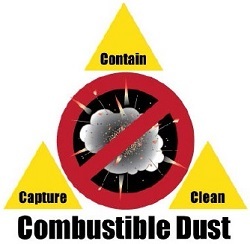 |
OSHA's new Emergency Preparedness for Farmworkers fact sheet focuses on the importance of creating and training workers in an emergency action plan to help lessen the impact of agricultural emergencies and disasters, whether natural or man-made. A fact sheet on Protecting Workers from Combustible Dust Explosion Hazards explains how to capture, contain and clean combustible dusts generated in a variety of workplaces before they become dispersed in clouds that present the risk of flash fires or explosions. Both fact sheets can be downloaded from OSHA's Publications webpage.
OSHA to host stakeholder meeting to discuss protecting tree care workers from injury or death
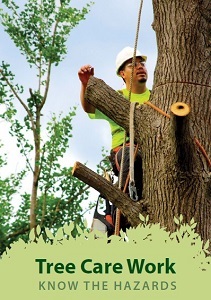 |
Tree trimming and removal operations expose workers to a variety of potentially fatal hazards including: falling from trees and aerial equipment; being hit by falling trees, flying objects and vehicular traffic; being cut by chain saws and chippers; and contacting energized power lines. To better protect tree care workers from injury or death, OSHA previously issued a hazard bulletin and trifold wallet card with valuable information for employers and workers.
Building on those efforts, OSHA will host an informal stakeholder meeting July 13 in Washington, D.C., to collect information on hazards in the tree care industry. Those interested in participating or observing canregister online. The agency will use the information gathered during this meeting to determine the need for a proposed rule. See the Federal Register notice for more details.
OSHA promotes safety in fireworks industry in light of July 4 festivities
 |
With Independence Day celebrations approaching, OSHA is encouraging the fireworks and pyrotechnics industry to protect workers from hazards while manufacturing, storing, transporting, displaying and selling fireworks for public events.
Fireworks can be deadly: In February, OSHA cited Texas Panhandle Heritage Foundation Inc.after a 21-year-old worker was killed during an outdoor pyrotechnics display. And last year, two workers were killed in an explosion at fireworks manufacturer Ultratec Special Effects Inc. in Alabama. The company was cited for 14 violations.
OSHA offers information on common hazards and solutions, including downloadable safety posters for workplaces. Also available is a training video that demonstrates best industry practices for retail sales and manufacturers based on National Fire Protection Association consensus standards.
Monday, June 20, 2016
New resource for OSH professionals helps advance worker safety and health through sustainability
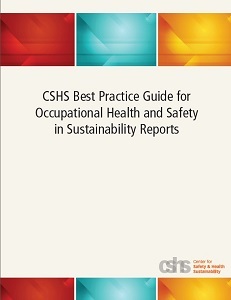 |
Over the last several years, businesses have made sustainability a key part of their growth strategy. While most of the focus has been on environmental issues, attention is now turning to other aspects of sustainability, including occupational safety and health. This shift presents new opportunities for OSH professionals to advance the protection of workers. The Center for Safety and Health Sustainability has released a Best Practice Guide for Occupational Health and Safety in Sustainability Reports, which outlines a framework that can be used to incorporate occupational health and safety metrics into sustainability reporting practices. The guide was developed through a collaborative process that included some of the world's largest OSH professional organizations and represents standards of performance which are already accepted, understood, and operationalized by those managing safety and health at work. By using this guide to engage with business leaders OSH professionals can take a critical step in improving occupational safety and health performance and, ultimately, preventing worker injuries, illnesses and fatalities. For more information, read CSHS's news release.
OSHA and NOAA provide guidance to protect outdoor workers from lightning strikes
OSHA and the National Oceanic and Atmospheric Administration have released a Lightning Safety When Working Outdoors Fact Sheet that provides employers and workers with information about lightning hazards and protective measures that can be taken to ensure workers’ safety. Often overlooked as an occupational hazard, lightning strikes can severely injure or kill workers in occupations such as construction, logging, utility repair, agriculture, telecommunications, lawn services, airport ground operations, and pool and beach lifeguarding.
Help keep workers SafeForLife during National Safety Month
 OSHA joins the National Safety Council and thousands of organizations across the country in recognizing June as National Safety Month. As part of an effort to emphasize the importance of safety both on and off the job, NSC's SafeForLife campaign highlights the leading causes of injury and death at work, on the roads, and in our homes and communities.Visit the SafeForLife website to take the SafeAtWork pledge and access downloadable materials including posters, tips sheets and games. You will also find a video,infographic and webinar taking place on June 14. A new NSC Safety Checkup web app provides a custom report on your specific safety risks.
OSHA joins the National Safety Council and thousands of organizations across the country in recognizing June as National Safety Month. As part of an effort to emphasize the importance of safety both on and off the job, NSC's SafeForLife campaign highlights the leading causes of injury and death at work, on the roads, and in our homes and communities.Visit the SafeForLife website to take the SafeAtWork pledge and access downloadable materials including posters, tips sheets and games. You will also find a video,infographic and webinar taking place on June 14. A new NSC Safety Checkup web app provides a custom report on your specific safety risks.
Summer heat safety campaign begins
 OSHA has kicked off its summer campaign to inform employers and employees about the dangers of working in the heat. The campaign will continue its annual outreach to highlight how heat-related worker fatalities are entirely preventable. In 2014 alone, 2,630 workers suffered from heat illness and 18 diedfrom heat stroke and related causes on the job.
OSHA has kicked off its summer campaign to inform employers and employees about the dangers of working in the heat. The campaign will continue its annual outreach to highlight how heat-related worker fatalities are entirely preventable. In 2014 alone, 2,630 workers suffered from heat illness and 18 diedfrom heat stroke and related causes on the job.
On May 26, Kelly Schnapp, who directs OSHA's Office of Science and Technology Assessment, joined four other experts on a White House webinar highlighting the risks of extreme heat to four vulnerable populations: the elderly, athletes, emergency responders, and outdoor workers. Schnapp noted that a majority of recent heat-related deaths investigated by OSHA involved workers on the job for three days or less – highlighting the need for employers to ensure that new workers become acclimated to the heat when starting or returning to work.
OSHA also provided heat safety tips for workers in a blog, Twitter posts, and an updated heat campaign webpage that now includes illustrations of heat exhaustion and heat stroke, an animated video, training resources, and links to an updated heat safety phone app. #WaterRestShade is the official hashtag of the campaign, encouraging employers to provide their workers with drinking water, ample breaks, and a shaded area while working outdoors. OSHA also continues to partner with the National Oceanic and Atmospheric Administration to raise awareness on the dangers of working in the heat through its Weather-Ready Nation campaign.
Wednesday, May 18, 2016
Preventing construction falls: infographics available
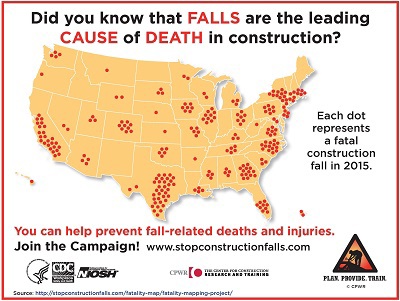 OSHA, the National Institute for Occupational Safety and Health and the Center for Construction Research and Training have developed a new series of infographics that illustrates the importance of preventing falls in construction. These infographics, available in both English and Spanish, raise awareness on fall hazards and resources for preventing them – including a ladder safety app. The infographics can be downloaded as PDFs or JPEGs for use in social media, presentations and print materials from stopconstructionfalls.com.
OSHA, the National Institute for Occupational Safety and Health and the Center for Construction Research and Training have developed a new series of infographics that illustrates the importance of preventing falls in construction. These infographics, available in both English and Spanish, raise awareness on fall hazards and resources for preventing them – including a ladder safety app. The infographics can be downloaded as PDFs or JPEGs for use in social media, presentations and print materials from stopconstructionfalls.com.
New fact sheets available on hazards related to scaffolds, marine terminals and confined spaces
Subscribe to:
Posts (Atom)





